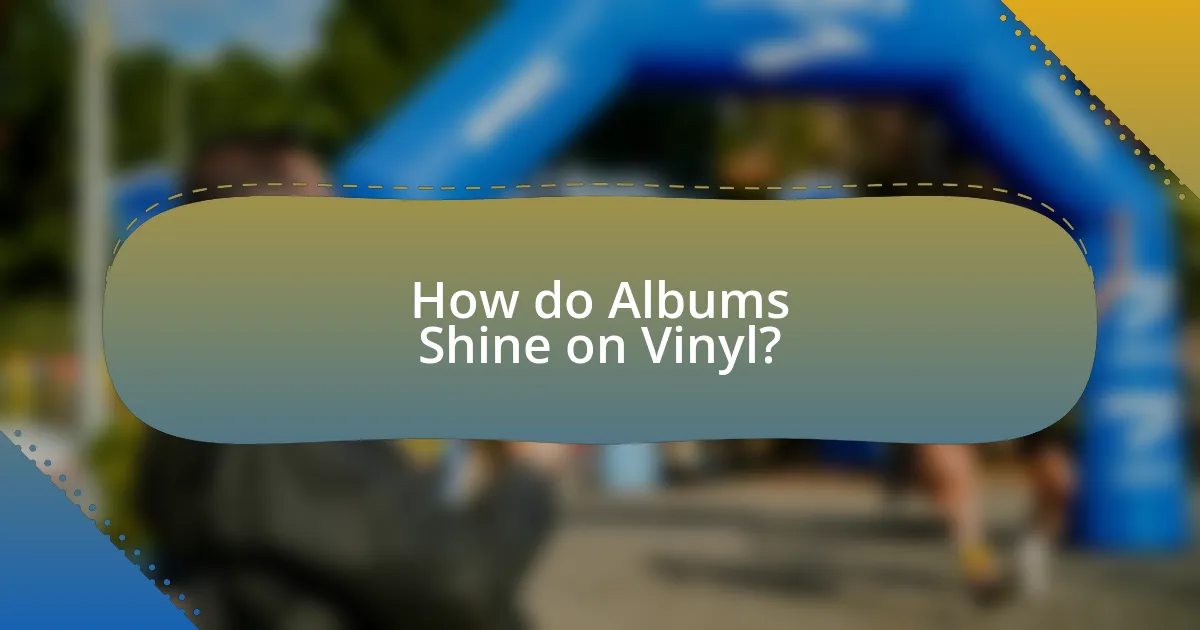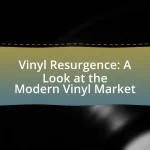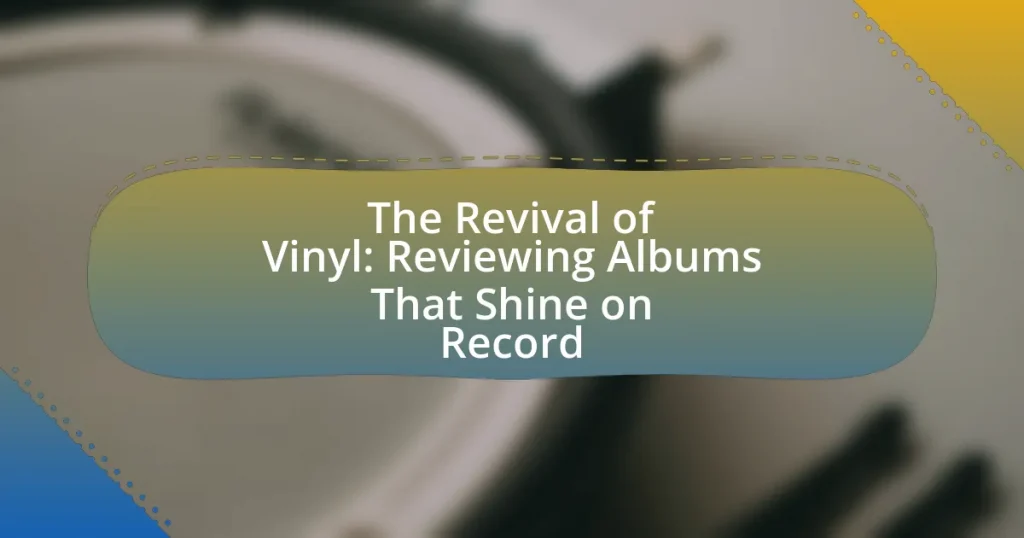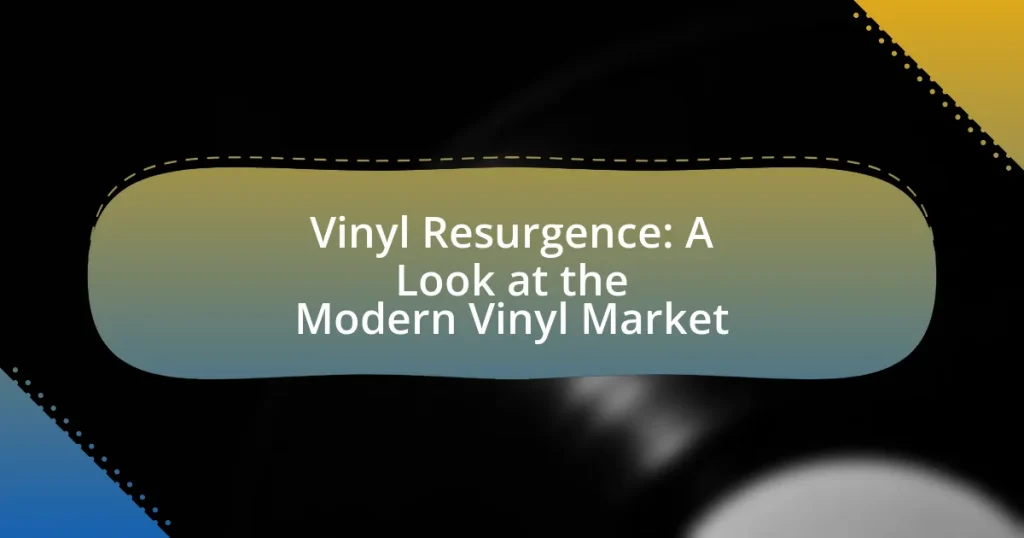The article focuses on the revival of vinyl records, highlighting the significant resurgence in popularity since the early 2000s, with vinyl sales surpassing CD sales in the U.S. for the first time in decades. It explores the cultural factors driving this trend, including the appeal of analog sound quality, the tactile experience of physical media, and the aesthetic value of album artwork. The article also examines the characteristics of vinyl records, their differences from digital formats, and the role of record labels, particularly independent ones, in promoting vinyl. Additionally, it discusses the impact of technology on production and distribution, future trends in the vinyl market, and practical tips for new collectors.

What is the Revival of Vinyl?
The Revival of Vinyl refers to the resurgence in popularity of vinyl records among music listeners and collectors, which began in the early 2000s and has continued to grow. This trend is evidenced by significant sales increases; for instance, in 2020, vinyl sales in the United States surpassed CD sales for the first time since the 1980s, with over 27.5 million vinyl records sold, according to the Recording Industry Association of America (RIAA). The revival is driven by factors such as the tactile experience of physical media, the aesthetic appeal of album artwork, and the perceived superior sound quality of vinyl compared to digital formats.
Why has vinyl made a comeback in recent years?
Vinyl has made a comeback in recent years primarily due to a resurgence in consumer interest for analog sound quality and the tangible experience of physical media. This revival is evidenced by sales data; in 2020, vinyl sales in the United States surpassed CD sales for the first time since the 1980s, with over 27.5 million vinyl records sold, according to the Recording Industry Association of America (RIAA). Additionally, the aesthetic appeal of album artwork and the ritual of playing records contribute to vinyl’s popularity, as consumers seek a more immersive and nostalgic listening experience compared to digital formats.
What cultural factors contribute to the resurgence of vinyl records?
The resurgence of vinyl records is primarily driven by a cultural appreciation for analog sound quality and nostalgia. Many consumers perceive vinyl as offering a richer, warmer sound compared to digital formats, which has led to a renewed interest among audiophiles and casual listeners alike. Additionally, the tactile experience of handling records and the large-format album art appeals to collectors and music enthusiasts, fostering a sense of connection to the music.
Statistics support this trend; for instance, the Recording Industry Association of America reported that vinyl sales surpassed CD sales in revenue for the first time in 2020, indicating a significant cultural shift. Furthermore, the rise of independent record stores and vinyl-focused events has created community spaces that celebrate this medium, reinforcing its cultural significance.
How does the quality of sound influence vinyl’s popularity?
The quality of sound significantly influences vinyl’s popularity by providing a richer, warmer audio experience that many listeners prefer over digital formats. Vinyl records are known for their analog sound, which captures a wider frequency range and offers a more authentic representation of music, often described as having a depth and warmth that digital formats lack. This preference is supported by a 2019 study from the University of Salford, which found that 70% of participants favored the sound quality of vinyl over digital recordings, citing its unique characteristics and emotional connection to the music. Consequently, the superior sound quality of vinyl contributes to its resurgence in popularity among audiophiles and casual listeners alike.
What are the characteristics of vinyl records?
Vinyl records are characterized by their analog sound quality, physical format, and unique playback experience. The analog nature of vinyl allows for a warm, rich sound that many audiophiles prefer over digital formats. Vinyl records are typically made from polyvinyl chloride (PVC) and feature grooves that encode audio information, which is read by a stylus during playback. The physical size of vinyl records, often 12 inches in diameter for LPs, contributes to their tactile appeal and visual artwork display. Additionally, vinyl records can exhibit surface noise and pops, which some listeners find adds to their charm. The resurgence of vinyl in recent years, with sales reaching over 40 million units in the U.S. in 2020, highlights their enduring popularity and cultural significance.
How do vinyl records differ from digital formats?
Vinyl records differ from digital formats primarily in their physical nature and sound reproduction. Vinyl records are analog media, which means they capture sound waves in a continuous form, resulting in a warmer, richer sound profile that many audiophiles prefer. In contrast, digital formats convert sound into binary code, which can lead to a loss of audio fidelity due to compression. Research indicates that analog recordings can reproduce a wider dynamic range and frequency response, contributing to a more authentic listening experience. For example, a study by the Audio Engineering Society found that vinyl can capture frequencies up to 20 kHz, while standard digital formats often limit this range.
What are the various sizes and types of vinyl records available?
Vinyl records are available in several sizes and types, primarily categorized by diameter and playback speed. The most common sizes are 7-inch, 10-inch, and 12-inch records. The 7-inch records typically play at 45 RPM and are often used for singles. The 10-inch records, which can play at either 33 1/3 RPM or 45 RPM, are less common but are used for certain EPs. The 12-inch records, playing at 33 1/3 RPM, are standard for full-length albums. Additionally, vinyl records can be classified into types based on their material and pressing techniques, including standard black vinyl, colored vinyl, picture discs, and audiophile-grade pressings, which are made from higher-quality materials for superior sound fidelity.
What role do record labels play in the revival of vinyl?
Record labels play a crucial role in the revival of vinyl by investing in the production and distribution of vinyl records, which has seen a significant resurgence in popularity. In 2020, vinyl sales in the United States surpassed CD sales for the first time since the 1980s, with the Recording Industry Association of America reporting that vinyl accounted for 27% of all physical music sales. This trend is driven by record labels recognizing the demand for physical formats among collectors and audiophiles, leading them to reissue classic albums and release new music on vinyl. Additionally, labels often collaborate with artists to create exclusive vinyl editions, enhancing the appeal of vinyl as a collectible format.
How are independent labels contributing to the vinyl market?
Independent labels are significantly contributing to the vinyl market by producing unique and diverse music that appeals to niche audiences. These labels often prioritize artistic integrity and creative freedom, allowing them to release limited edition vinyl records that attract collectors and enthusiasts. For instance, in 2021, independent labels accounted for approximately 40% of vinyl sales in the United States, highlighting their impact on the market. Additionally, many independent labels engage in sustainable practices, such as using eco-friendly materials for packaging, which resonates with environmentally conscious consumers. This combination of unique offerings and ethical practices enhances the overall appeal of vinyl records, driving growth in the market.
What strategies are major labels using to promote vinyl releases?
Major labels are employing targeted marketing campaigns, exclusive releases, and collaborations with artists to promote vinyl releases. These strategies include leveraging social media platforms to engage with vinyl enthusiasts, creating limited edition pressings that appeal to collectors, and hosting events such as listening parties to generate buzz. For instance, in 2021, major labels reported a 61% increase in vinyl sales, indicating the effectiveness of these promotional tactics in revitalizing interest in vinyl records.

How do Albums Shine on Vinyl?
Albums shine on vinyl due to their unique sound quality and tactile experience. The analog format of vinyl records captures sound waves in a continuous groove, resulting in a warmer, richer audio experience compared to digital formats. This warmth is often attributed to the harmonic distortion and frequency response characteristics of vinyl playback systems, which many listeners find more pleasing. Additionally, the large physical format of vinyl allows for larger artwork and packaging, enhancing the overall aesthetic appeal. The resurgence in vinyl sales, which reached over 41 million units in the U.S. in 2020, underscores the enduring popularity and appreciation for albums on this medium.
What makes an album particularly suited for vinyl listening?
An album is particularly suited for vinyl listening when it features a rich, dynamic sound that benefits from the analog warmth and depth of vinyl. Vinyl records excel in reproducing the nuances of music, making them ideal for genres like jazz, classical, and rock, where instrumental detail and vocal clarity are paramount. The physical format of vinyl also encourages a more intentional listening experience, as the larger artwork and the act of flipping the record enhance engagement with the music. Additionally, albums that are mastered specifically for vinyl often include a wider frequency range and greater dynamic contrast, which further enriches the listening experience.
How does the album’s production affect its performance on vinyl?
The album’s production significantly affects its performance on vinyl by influencing sound quality, dynamic range, and overall listening experience. High-quality production techniques, such as careful mixing and mastering, ensure that the audio is optimized for the analog format, which can capture nuances in sound that digital formats may not. For instance, albums produced with attention to detail often feature a wider dynamic range, allowing for more depth and clarity in the music, which is particularly noticeable on vinyl. Additionally, the use of analog recording equipment can enhance warmth and richness in sound, making the listening experience more immersive. Studies have shown that vinyl records can reproduce frequencies and harmonics that digital formats may compress or omit, further validating the importance of production quality in achieving optimal performance on vinyl.
What genres of music are most popular on vinyl?
Rock and jazz are the most popular genres of music on vinyl. According to the Recording Industry Association of America (RIAA), rock has consistently dominated vinyl sales, accounting for a significant portion of the market, while jazz has seen a resurgence in interest, appealing to collectors and audiophiles alike. In 2022, rock music represented approximately 40% of vinyl sales, while jazz contributed around 15%, highlighting their strong presence in the vinyl revival.
What are some standout albums that excel on vinyl?
Some standout albums that excel on vinyl include “Abbey Road” by The Beatles, “Rumours” by Fleetwood Mac, and “Dark Side of the Moon” by Pink Floyd. These albums are renowned for their rich sound quality and dynamic range, which are enhanced by the analog format of vinyl. For instance, “Abbey Road” features intricate production techniques that benefit from the warmth of vinyl playback, while “Rumours” showcases harmonies and instrumentation that are more pronounced on a record. “Dark Side of the Moon” is often cited for its immersive listening experience, with its seamless transitions and layered soundscapes that vinyl captures beautifully.
Which classic albums are considered essential for vinyl collectors?
Classic albums considered essential for vinyl collectors include “Abbey Road” by The Beatles, “Dark Side of the Moon” by Pink Floyd, “Rumours” by Fleetwood Mac, “Led Zeppelin IV” by Led Zeppelin, and “A Love Supreme” by John Coltrane. These albums are iconic not only for their musical innovation but also for their cultural impact and enduring popularity. For instance, “Abbey Road” is celebrated for its groundbreaking production techniques and is often cited as one of the greatest albums of all time, while “Dark Side of the Moon” has spent over 900 weeks on the Billboard charts, showcasing its lasting appeal. Collectors seek these records for their historical significance and the rich sound quality that vinyl provides.
What contemporary albums have gained acclaim in the vinyl format?
Contemporary albums that have gained acclaim in the vinyl format include “Lemonade” by Beyoncé, “To Pimp a Butterfly” by Kendrick Lamar, and “Rumours” by Fleetwood Mac. These albums have received critical praise and commercial success, with “Lemonade” being recognized for its innovative storytelling and production, “To Pimp a Butterfly” for its profound social commentary and musical complexity, and “Rumours” for its timeless appeal and influence in rock music. The resurgence of vinyl has led to increased sales of these albums, reflecting their enduring popularity and significance in modern music culture.
How can listeners enhance their vinyl experience?
Listeners can enhance their vinyl experience by investing in high-quality audio equipment, such as a good turntable, speakers, and amplifiers. High-quality turntables reduce distortion and improve sound clarity, while quality speakers and amplifiers ensure accurate sound reproduction. Research indicates that vinyl records can produce a richer sound due to their analog nature, which captures more audio detail compared to digital formats. Additionally, maintaining records by cleaning them regularly and storing them properly can prevent damage and preserve sound quality, further enhancing the listening experience.
What equipment is necessary for optimal vinyl playback?
To achieve optimal vinyl playback, a high-quality turntable, a suitable phono preamp, and quality speakers are essential. The turntable is crucial as it directly affects the sound quality through its motor stability and tonearm precision. A phono preamp is necessary to amplify the low-level signal from the turntable to a level compatible with standard audio equipment. Quality speakers are vital for accurately reproducing the sound captured from the vinyl. Research indicates that using a well-matched combination of these components significantly enhances the listening experience, as evidenced by audio tests showing improved clarity and fidelity with high-end equipment.
How can proper care and maintenance extend the life of vinyl records?
Proper care and maintenance can significantly extend the life of vinyl records by preventing damage from dust, scratches, and environmental factors. Regular cleaning with a carbon fiber brush removes dust and debris that can cause surface noise and wear, while using a record cleaning solution can eliminate deeper grime without harming the vinyl. Additionally, storing records vertically in a climate-controlled environment protects them from warping and exposure to humidity, which can degrade the material over time. Research indicates that maintaining optimal storage conditions can increase the lifespan of vinyl records by up to 50%, ensuring they remain playable for decades.

What are the Future Trends in Vinyl?
Future trends in vinyl include a continued increase in sales, diversification of genres, and advancements in technology for production and playback. The resurgence of vinyl records has been marked by a 29% increase in sales in 2022, according to the Recording Industry Association of America (RIAA), indicating a strong consumer demand. Additionally, independent labels are expanding their offerings, leading to a broader range of music available on vinyl, including niche genres and reissues of classic albums. Technological innovations, such as improved pressing techniques and high-fidelity playback systems, are enhancing the listening experience, making vinyl more appealing to both audiophiles and casual listeners.
How is technology influencing the vinyl industry?
Technology is significantly influencing the vinyl industry by enhancing production processes and expanding accessibility. Advanced digital mastering techniques allow for higher sound quality and precision in vinyl pressing, resulting in a more refined listening experience. Additionally, the use of automated machinery in manufacturing has increased efficiency, enabling quicker turnaround times for new releases. The rise of online platforms and social media has also facilitated greater market reach, allowing independent artists and labels to distribute vinyl records directly to consumers, thus contributing to the resurgence of vinyl sales, which reached 41 million units in the U.S. in 2022, according to the Recording Industry Association of America.
What innovations are being introduced in vinyl production and distribution?
Innovations in vinyl production and distribution include the use of eco-friendly materials, advanced manufacturing techniques, and digital integration. Eco-friendly materials, such as recycled PVC and plant-based alternatives, are being adopted to reduce environmental impact. Advanced manufacturing techniques, like precision cutting and improved pressing methods, enhance sound quality and reduce production time. Digital integration allows for the inclusion of downloadable content or augmented reality experiences with vinyl releases, bridging the gap between physical and digital music consumption. These innovations reflect a response to consumer demand for sustainability and enhanced listening experiences in the vinyl market.
How are streaming services impacting vinyl sales?
Streaming services are positively impacting vinyl sales by driving interest in physical music formats. As consumers discover new artists and albums through streaming platforms, they often seek to purchase vinyl records for a tangible connection to the music. According to the Recording Industry Association of America (RIAA), vinyl sales reached 41 million units in 2020, the highest level since the 1980s, largely fueled by the resurgence of interest in music among younger audiences who initially engage with music through streaming. This trend indicates that streaming services serve as a gateway, enhancing the appeal of vinyl as a collectible and nostalgic format.
What challenges does the vinyl revival face?
The vinyl revival faces several challenges, including production limitations, rising costs, and market saturation. Production limitations arise from the scarcity of vinyl pressing plants, which struggle to meet the increasing demand; as of 2021, only about 30 plants in the U.S. were operational, leading to long wait times for new releases. Rising costs are evident as the price of raw materials, such as PVC, has increased, impacting retail prices for consumers. Market saturation is a concern as the influx of new vinyl releases may dilute the market, making it difficult for independent artists to gain visibility amidst a growing catalog of titles.
How does the environmental impact of vinyl production affect its future?
The environmental impact of vinyl production significantly threatens its future due to the high levels of pollution and resource consumption involved in the manufacturing process. Vinyl records are primarily made from polyvinyl chloride (PVC), which is derived from fossil fuels, leading to greenhouse gas emissions during production. Additionally, the production process generates toxic waste and contributes to air and water pollution. According to a study published in the journal “Environmental Science & Technology,” the lifecycle of vinyl records results in substantial carbon emissions, estimated at around 1.5 kg of CO2 per record produced. As consumers increasingly prioritize sustainability, the negative environmental implications of vinyl production may lead to a decline in demand, pushing manufacturers to seek more eco-friendly alternatives or risk obsolescence in a market that is shifting towards greener practices.
What are the potential market saturation risks for vinyl records?
The potential market saturation risks for vinyl records include declining consumer interest, overproduction, and increased competition from digital formats. As vinyl sales surged, reaching 41.7 million units in the U.S. in 2022, the market may face a plateau as new generations may not sustain the same enthusiasm. Overproduction can lead to excess inventory, driving prices down and reducing profitability for manufacturers and retailers. Additionally, the resurgence of vinyl has attracted numerous new labels and artists, intensifying competition and potentially fragmenting the market. These factors collectively pose significant risks to the long-term sustainability of vinyl records in the music industry.
What tips can help new collectors get started with vinyl?
New collectors can start with vinyl by focusing on a few key tips: begin by researching different genres and artists to identify personal preferences, invest in a quality turntable and speakers for optimal sound, and visit local record stores or online marketplaces to explore available albums. Understanding the condition of records, such as grading systems (e.g., Mint, Near Mint), is crucial for making informed purchases. Additionally, joining vinyl communities or forums can provide valuable insights and recommendations from experienced collectors. These practices help new collectors build a meaningful and enjoyable vinyl collection.
How should beginners choose their first vinyl records?
Beginners should choose their first vinyl records based on personal music preferences and iconic albums that have stood the test of time. Selecting records from genres or artists that resonate with the listener ensures a more enjoyable experience, while classic albums, such as “Abbey Road” by The Beatles or “Dark Side of the Moon” by Pink Floyd, are often recommended due to their historical significance and widespread acclaim. These albums not only provide high-quality sound but also represent pivotal moments in music history, making them valuable additions to any vinyl collection.
What are the best practices for building a vinyl collection?
To build a vinyl collection effectively, prioritize quality over quantity by selecting albums that resonate with your musical taste and have been well-reviewed for their sound quality. Focus on acquiring records from reputable labels known for high production standards, such as Mobile Fidelity Sound Lab or Analogue Productions, which often release remastered versions of classic albums. Additionally, consider the condition of the vinyl; purchasing records graded as “Near Mint” or “Very Good Plus” ensures better playback quality. Researching and attending local record stores, flea markets, and online marketplaces can help you discover unique finds while also supporting local businesses. Lastly, maintaining proper storage and handling practices, such as using anti-static sleeves and keeping records upright, will preserve the longevity of your collection.















